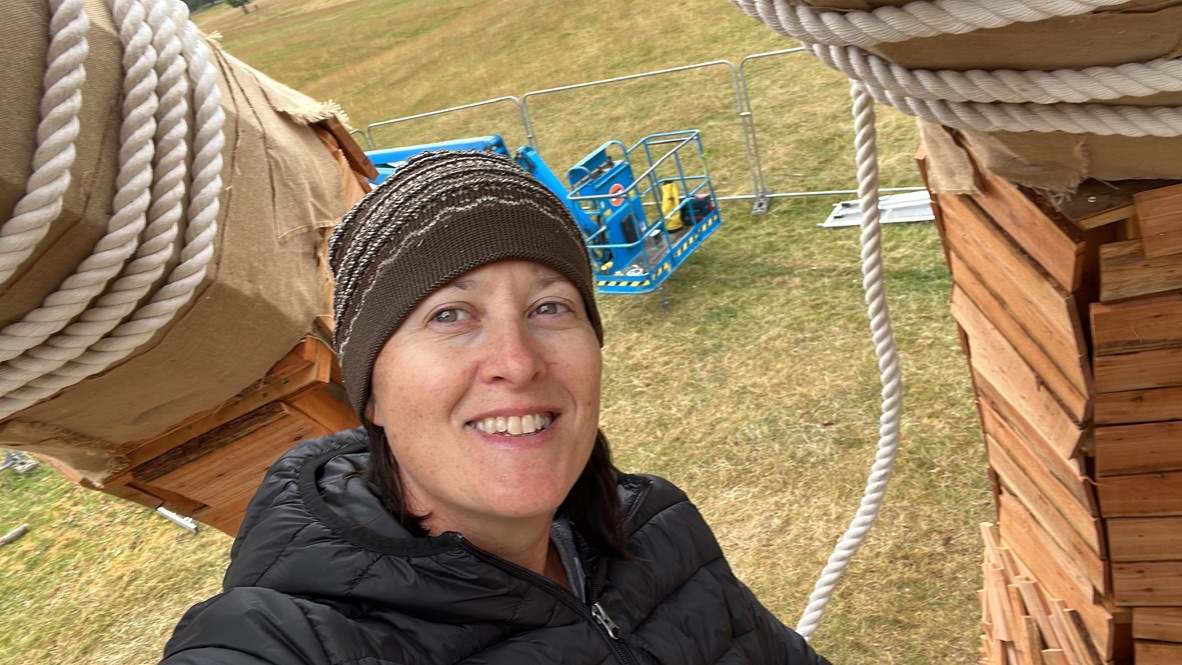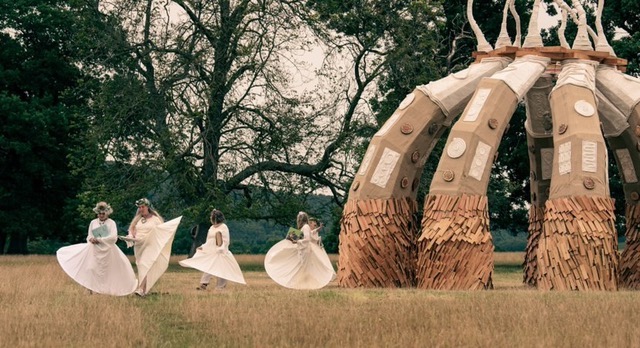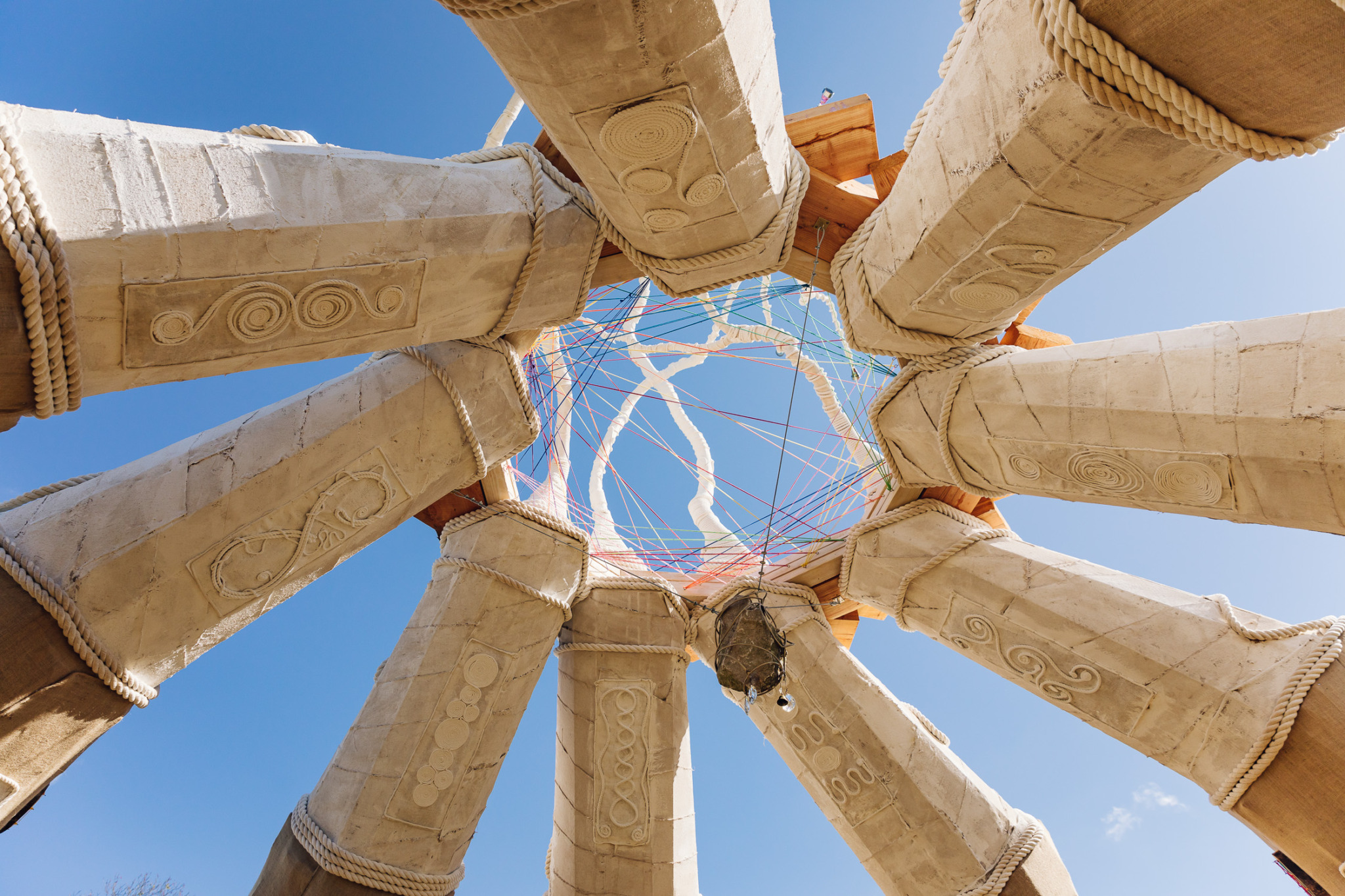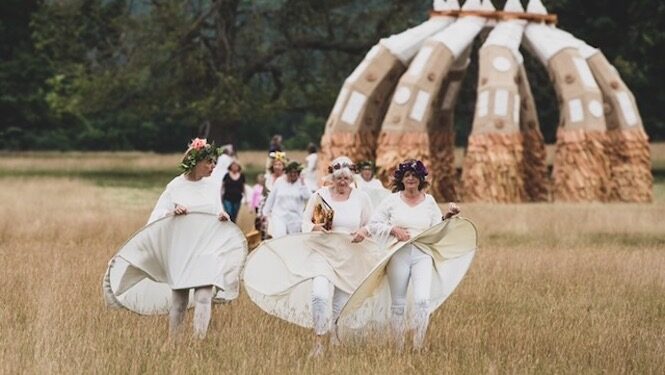In early 2021 Burning Man artist Rebekah Waites got a call she probably wasn’t anticipating. The voice on the line said something like, “Would you like to build and burn one of your large-scale sculptures at a British estate in rural England?” Less than a year later, thousands gathered on the grounds of Chatsworth House for a spectacular procession, rousing community celebration, and cathartic burn of her communally-built piece “Relevé.”
Read the rest of this three-part Chatsworth series here.
Rebekah is probably most well known in Burning Man circles for her provocative and beloved 2013 Honoraria Black Rock City piece, “Church Trap.” She again delighted Burners with “Singularity” in 2018, and plans to bring an early iteration of “Ripple Effect.” We were thrilled to sit down with Rebekah to learn more about her creative process and her experience creating artwork for Radical Horizons.

Can you talk a little bit about your earliest memories of your relationship with creativity, and how you got to know your own creative energy?
I have some very fond memories from when I was a kid. I was always drawing. I grew up in a hostile home environment, so drawing was the safest thing for me to do. It kept me quiet and out of trouble. I specifically remember my mom finding a wooden box of oil paints. It was hers. She had started taking a painting class, and then she just put it up in the garage. But then she gave it to me. I taught myself how to oil paint when I was maybe 10 years old. My Mom would buy a big roll of butcher paper and just roll it out on the table and then give all the kids markers and pens, and we would just sit there for hours and draw. I don’t know why, but it was just so much fun.
Where did you grow up?
I grew up in Orange County, California, just north of Disneyland. You can hear the fireworks from my mom’s house.
Did you carry that identity as an artist from your childhood into adulthood, or when did you first identify yourself as an artist?
It was really that box of paint. Something clicked, and I just started painting. I always knew that I had the ability to draw really well and [I had] a very big imagination. When I got to high school, it really took off. So I’d been painting since I was a kid and I did a lot of art shows as an adult and all that stuff, but I was just really floundering as a painter. It’s so hard to get into galleries. I’m a bit of an introvert so it’s hard for me to go up and just talk to somebody and be like, “Hey, I’m really great at this and that.” I just can’t do that. Selling myself has always been difficult. And so when “Church Trap” happened, that’s when my career really took off.
How and why did you first go to Burning Man? What called you to the desert?
I always had this curiosity about Burning Man. When I went, I just kind of felt so out of place. I was not good with costumes and all the other things. My first year was 2006. I can’t even remember what the theme was for that year [Hope and Fear: The Future. We couldn’t remember, either]. I remember the Temple. I was like a weekend warrior. I didn’t know what the hell I was doing. Total amateur hour. It was pretty embarrassing. I have an embarrassing story that I don’t think I should tell involving a police officer… It’s how I got my playa name, “Probable Cause.” We’ll leave it at that.
“Church Trap” had a profound impact on so many people. Where did the idea come from, and how did creating that piece change the trajectory of your life?
We were having a party at my house and one of my good friends, Dusty, was there. I had gotten involved with the Orange County Burning Man community. He’s a big member of that community, and he deserves a shout out because it’s kind of his fault that this happened. I told him, “I have this idea of a big mouse trap.” And I was kind of tongue in cheek talking about it. And he’s like, “You need to apply for a grant.” I didn’t know that they [Burning Man Project] offered that. I started looking into it, and when they announced the theme [Cargo Cult] that’s when all the stars aligned in a way. It just hit me what this project was going to be.

I grew up in a very, almost cult-like Christian upbringing. My mom, bless her heart, was very much involved in Apocalyptic Christianity, a cult movement of the seventies and eighties. I was a little bit traumatized by it because it really pushed this agenda that the end times were coming. And if you don’t get saved, you’re going to die. You’re going to get left behind. So I really struggled with that as a kid. I had a big family so if I came home and everyone was gone, my first thought was, “Oh, I definitely sinned and now I’m going to have to fend for myself.”
That whole experience of growing up around that very Bible-thumpy brainwashing really affected my childhood, my adulthood, coming out of the closet, and having a relationship with my mother, all of that stuff. I put all of that into “Church Trap.”
I had no idea it was going to resonate with so many people. It was just a very personal piece for me. I didn’t have any idea that any other people, that there were other people out there who went through the same thing that I did as a kid and as a young adult. It was really moving to actually connect with folks that are like, “That happened to me too.”

Turning to your participation in Radical Horizons: The Art of Burning Man at Chatsworth, can you describe the piece “Relevé” for us?
The Nine Ladies Stone Circle kept popping up in conversations. The story is of these women gathering. They’re out dancing because women out dancing is clearly very threatening, a big no-no, and it was on the Sabbath, on Sunday. Then they got turned to stone by a group of men. That is a topic that I would like to explore more in art. Growing up as a woman and continually being told that I can’t do things in a way is being turned into stone. You stop thinking about that thing that you wanted to do. Your dream stops at that moment. It turns to stone.
“Relevé” is not only inspired by the Nine Lady Stone Circle, but also my experiences growing up with my grandma, my aunt, my aunt and I. My Aunt Mary and I are really close. She’s an amazing artist as well. She does a lot of knitting and other amazing stuff. I have so many blankets that my grandmothers have made for me, and that’s the only thing I have left from them. Those things are really special to me.

This whole idea around how, as women, how integrated it is with making your clothes, making, providing blankets, providing clothes and comfort for your loved ones… The idea of how stitching and fabric work, which is almost like a glue for your families to be dressed and have a warm bed. I integrated those techniques into the piece.
I was also really inspired by the dust devils at Burning Man. That phenomenon when the pieces are burning and then you get the tornadoes coming out. I kind of like putting them all together. The idea of these women dancing and their dresses spinning and the tornadoes spinning, just seeing the fabric and the embroidery work and what that would all look like. I brought them all together in this large twisted space.

How did working with school groups impact the process and meaning of the piece?
In my past life I taught art for the Fullerton School District. I’d go in and teach art with kids in kindergarten through sixth grade. Then I started volunteering with kids that are terminally ill. I’d go to their homes and do art lessons with them and their siblings and stuff. So working with kids has always been something that’s really special. It’s so important to work with kids and with art, to teach them that it’s something that they can do, that you can create a piece of art that gets put on a big art installation, or something that you take home and put on your wall — that you can do it. Working with the kids [on “Relevé”] was really, really special. It was probably one of the highlights of that whole experience.
I was thrilled to be there for the closing weekend and the burn. I was really moved by the community that showed up to participate, especially the little children. How was that final burn experience for you?
I was the most nervous that I’ve ever been with a piece, because of the challenges that went into making it. So It was kind of bittersweet for me. But at the end when we burned it down and I was getting pulled in all these directions and getting interviewed, and then all of a sudden I hear all this, all these little voices, “Rebekah!” And I just stopped and I turned around and there was like a group of these little kids, and I just ran over there and just started talking to them. And it was so cute. Oh my God. One of my favorite moments was just hearing those voices. They were talking about wanting to do art themselves, and there’s a bunch of little girls in the group. It was just really cute. It was really sweet.
Any final thoughts?
None of this can happen without the people around me. Going back to the community, from my girlfriend’s support to Kevin Linky, my build lead, and people like Kim, the crews that I’ve been able to work with. To make big art requires a village. And that village also deserves the same amount of praise as I get as the artist and the creator. It’s all of us making it, not just one person.
Cover image of “Relevé” by Rebekah Waites, 2022 (Photo by Andy Tudor)


Good interview, Rebekah & Megan!!
Report comment
Comments are closed.